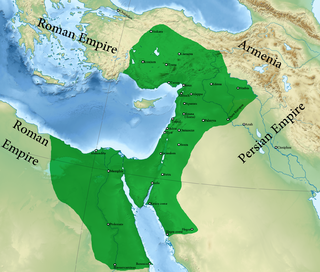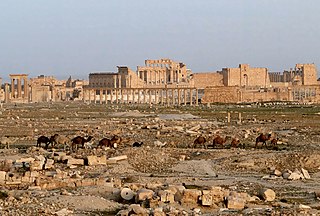
The 100s decade ran from January 1, 100, to December 31, 109.
Year 108 (CVIII) was a leap year starting on Saturday of the Julian calendar. At the time, it was known as the Year of the Consulship of Trebonius and Bradua. The denomination 108 for this year has been used since the early medieval period, when the Anno Domini calendar era became the prevalent method in Europe for naming years.

Septimia Zenobia was a third century queen of the Palmyrene Empire in Syria. Many legends surround her ancestry; she was probably not a commoner and she married the ruler of the city, Odaenathus. Her husband became king in 260, elevating Palmyra to supreme power in the Near East by defeating the Sassanians and stabilizing the Roman East. After Odaenathus' assassination, Zenobia became the regent of her son Vaballathus and held de facto power throughout his reign.

Dura-Europos, also spelled Dura-Europus, was a Hellenistic, Parthian and Roman border city built on an escarpment 90 metres above the right bank of the Euphrates river. It is located near the village of Salhiyé, in today's Syria. In 113 BC, Parthians conquered the city, and held it, with one brief Roman intermission, until 165 AD. Under Parthian rule, it became an important provincial administrative centre. The Romans decisively captured Dura-Europos in 165 AD and greatly enlarged it as their easternmost stronghold in Mesopotamia, until it was captured by the Sasanian Empire after a siege in 256–57 AD. Its population was deported, and after it was abandoned, it was covered by sand and mud and disappeared from sight.

Septimius Odaenathus was the founder king (Mlk) of the Palmyrene Kingdom who ruled from Palmyra, Syria. He elevated the status of his kingdom from a regional center subordinate to Rome into a formidable state in the Near East. Odaenathus was born into an aristocratic Palmyrene family that had received Roman citizenship in the 190s under the Severan dynasty. He was the son of Hairan, the descendant of Nasor. The circumstances surrounding his rise are ambiguous; he became the lord (ras) of the city, a position created for him, as early as the 240s and by 258, he was styled a consularis, indicating a high status in the Roman Empire.

A hypogeum or hypogaeum is an underground temple or tomb.

The Palmyrene Empire was a short-lived splinter state of the Roman Empire resulting from the Crisis of the Third Century. Named after its capital and largest city, Palmyra, at its height it encompassed the Roman provinces of Syria Palaestina, Arabia Petraea, and Egypt, as well as large parts of Asia Minor.

Malakbel was a sun god worshiped in the ancient Syrian city of Palmyra, frequently associated and worshiped with the moon god Aglibol as a party of a trinity involving the sky god Baalshamin.

The National Museum of Damascus is a museum in the heart of Damascus, Syria. As the country's national museum as well as its largest, this museum covers the entire range of Syrian history over a span of over 11 millennia, and displays various important artifacts, relics and major finds most notably from Mari, Ebla and Ugarit, three of Syria's most important ancient archaeological sites. Established in 1919, during King Faisal's Arab Kingdom of Syria, the museum is the oldest cultural heritage institution in Syria.

Palmyrene was a historical Semitic alphabet used to write the local Palmyrene dialect of Aramaic. It was used between 100 BCE and 300 CE in Palmyra in the Syrian desert. The oldest surviving Palmyrene inscription dates to 44 BCE. The last surviving inscription dates to 274 CE, two years after Palmyra was sacked by Roman Emperor Aurelian, ending the Palmyrene Empire. Use of the Palmyrene language and script declined, being replaced with Greek and Latin.

Palmyra is an ancient Semitic city in present-day Homs Governorate, Syria. Archaeological finds date back to the Neolithic period, and documents first mention the city in the early second millennium BC. Palmyra changed hands on a number of occasions between different empires before becoming a subject of the Roman Empire in the first century AD.

The Temple of Baalshamin was an ancient temple in the city of Palmyra, Syria, dedicated to the Canaanite sky deity Baalshamin. The temple's earliest phase dates to the late 2nd century BC; its altar was built in 115 AD, and the temple was substantially rebuilt in 131 AD. The temple would have been closed during the persecution of pagans in the late Roman Empire in a campaign against the temples of the East made by Maternus Cynegius, Praetorian Prefect of Oriens, between 25 May 385 to 19 March 388. With the spreading of Christianity in the region in the 5th century AD, the temple was converted to a church.

The Tower of Elahbel was a four-storey sandstone tower tomb near the ancient city of Palmyra in Syria. The tower was one of several built outside the city walls of Palmyra, in an area known as the Valley of the Tombs. The tower was important in the history of textiles: fragments of very early Chinese silk yarns, dated to the 1st century AD, were discovered in the tombs at the tower. The tower was demolished using explosives by the Islamic State of Iraq and the Levant in August 2015.

The Monumental Arch, also called the Arch of Triumph or the Arch of Septimius Severus, was a Roman ornamental archway in Palmyra, Syria. It was built in the 3rd century during the reign of emperor Septimius Severus. Its ruins later became one of the main attractions of Palmyra until it was officially destroyed by the Islamic State of Iraq and the Levant (ISIL) in 2015. Most of its stonework still survives and there are plans to rebuild it using anastylosis.

Palmyrene funerary relief busts were first produced in Palmyra in the middle of the first century BC a decorative slabs closing the burial niches inside underground tombs. The reliefs were carved into square pieces of limestone and depicted figures in a direct frontal pose cut off at mid-torso. Arms and hands were portrayed in various gestures and poses. Most busts display a solitary figure, however some sculptures incorporate multiple figures of family members. Names and lineage of the deceased are engraved in Aramaic above the shoulders, and in some cases, with Greek or Syriac.

The Sack of Bostra occurred around the spring of 270 AD when Queen Zenobia of Palmyra sent her general, Zabdas, to Bostra, the capital of Arabia Petraea to subjugate the Tanukhids who were challenging Palmyrene authority.
Rubina Raja is a Danish classical scholar, specialising in ancient iconography, especially portraits from Palmyra. She is Professor of Classical Archaeology at Aarhus University and leads The Danish National Research Foundation's Center of Excellence for Urban Network Evolutions.
The Temple of the Gadde is a double temple in the Syrian city of Dura-Europos, located near the agora. It was dedicated to the protective deities of Dura-Europos and the nearby city of Palmyra. It was excavated between 1934 and January 1936 by the French/American expedition of Yale University, led by Michael Rostovtzeff.

Odaenathus, the king of Palmyra from 260 to 267, has been identified by modern scholars as the subject of various sculptures, seal impressions, and mosaic pieces. Odaenathus presided over Palmyra's apogee, when he defeated the Sasanian emperor of Persia Shapur I in 260, and besieged him in his capital Ctesiphon in 263. In the aftermath of his Persian war, Odaenathus assumed the title King of Kings, elevating his son Herodianus as co-ruler. Odaenathus' title was a challenge to the Persian monarch's claims of authority in the region, and the thirteenth Sibylline Oracle, a collection of prophecies, includes an account contemporary to Odaenathus prophesying that Odaenathus will kill Shapur I, who was mentioned as a beast.

The Valley of the Tombs is a necropolis at the west of Palmyra, Syria. It is one of the three necropoleis present around the ancient city. It is one kilometre long, and easily recognizable by its tower-tombs, among which the former towers of Atenatan, Kitot, Iamblichus and Elahbel where the earliest finds of silk were made and that were destroyed by ISIS in 2015.
















